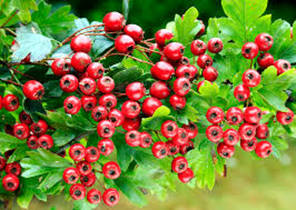Hawthorn: A Beginner’s Guide to Its Health Benefits and Uses
- Catherine Dunne

- Feb 28
- 6 min read
Updated: Mar 7
By Dr Catherine W Dunne MSc. D., RGN, Reiki Master (RGMT), M.H.I.T: Master Acupressure, Practitioner of Reflexology, Aromatherapy, Deep Tissue/Myo-fascia Massages, Infrared Treatments, Vibrational Sound and Colour Therapist, Tissue Salt Advisor, Pendulum Healing Dowser, Chakra Practitioner , Tao Cosmic Healing Practitioner, Practitioner of Plant and Herb Medicine and Nurse.

Hawthorn (Crataegus) is a small, thorny tree that has been used in herbal medicine for centuries. Its leaves, flowers, and bright red berry-like fruits—known as “haws”—have traditionally been used to support heart health, digestion, and overall well-being.
Today, modern research is beginning to confirm what herbalists have long known: hawthorn contains powerful plant compounds that may help protect the heart, regulate blood sugar, and even fight harmful bacteria. In this beginner-friendly guide, we’ll explore the benefits of hawthorn, how to use it safely, and what dosage is recommended.
What Is Hawthorn?
Hawthorn is a plant that belongs to the Rosaceae (rose) family. While there are hundreds of species, the most commonly used medicinal variety is Crataegus monogyna. This tree is native to Europe but is also found in North America and North Africa.
Hawthorn is often recognized by its small red fruits, which resemble berries but actually contain a seed or “stone,” making them more like miniature apples. The plant has been used in Traditional Chinese Medicine (TCM), European herbalism, and Native American healing traditions for centuries.
Health Benefits of Hawthorn

1. Heart Health and Blood Pressure Support
Hawthorn is widely known for its cardiovascular benefits. Scientific studies suggest it may help:
✔ Improve circulation by dilating blood vessels and increasing blood flow ✔ Lower cholesterol and reduce harmful fats in the blood ✔ Support healthy blood pressure levels ✔ Protect the heart with its strong antioxidant and anti-inflammatory properties
A 2020 scientific review found that hawthorn may help prevent atherosclerosis, a condition where arteries narrow due to plaque buildup. However, if you have a heart condition or take medication for blood pressure, consult your doctor before using hawthorn.
2. Blood Sugar and Diabetes Management
If you struggle with high blood sugar or diabetes, hawthorn may be beneficial. A 2022 review found that hawthorn:
✔ Helps regulate blood sugar and insulin levels ✔ Lowers triglycerides (a type of fat in the blood linked to diabetes complications) ✔ Reduces inflammation and oxidative stress in the body ✔ Improves the function of pancreatic cells, which help regulate blood sugar ✔ May help reduce factors that can lead to obesity
While promising, most of these studies were done on animals. More human research is needed before hawthorn can be recommended as a treatment for diabetes.
3. Antioxidant and Anticancer Properties
Hawthorn berries are rich in polyphenols, a type of antioxidant that fights cell damage. A 2021 study found that hawthorn extracts:
✔ Killed brain tumour cells in lab tests ✔ Inhibited the growth and spread of harmful cells
This suggests hawthorn may have anticancer potential, but much more research is needed before it can be considered a cancer treatment.
4. Digestive Health and Gut Support
Traditionally, hawthorn has been used to aid digestion. Studies suggest it may:
✔ Speed up digestion by increasing gut motility ✔ Reduce bloating and indigestion ✔ Act as a natural prebiotic, supporting good gut bacteria
Animal studies show that hawthorn extracts help food move through the digestive tract faster, but human studies are still needed.
5. Antimicrobial and Immune-Boosting Benefits
Hawthorn may help fight infections due to its natural antibacterial properties. A 2020 study indicated that the berries of Crataegus azarolus, which is a hawthorn species that grows in the Mediterranean, may be effective against seven different microorganisms and gram positive bacteria. Antimicrobial substances may kill or prevent the growth of potentially harmful microorganisms:
✔ Were effective against seven types of harmful bacteria ✔ Contained complex carbohydrates and antioxidants that may support the immune system
This suggests hawthorn could be useful in natural cold and flu remedies.
How to Use Hawthorn: Forms & Dosage Recommendations
1. Fresh or Dried Berries
How to Use: ✔ Eat fresh berries in small amounts ✔ Make hawthorn tea (steep dried berries in hot water for 10–15 minutes) ✔ Use dried berries in herbal blends
Dosage: ✅ Tea: 1–2 teaspoons of dried berries per cup, up to 3 times daily
2. Hawthorn Tincture (Liquid Extract)
How to Use: ✔ Add drops to water or juice ✔ Usually comes in alcohol or glycerine-based extracts
Dosage: ✅ Tincture: 1–2 ml (20–40 drops) up to 3 times daily
3. Capsules or Tablets
Many people prefer standardized hawthorn supplements, which contain a concentrated dose of the active compounds.
Dosage: ✅ Capsules:250–500 mg up to 3 times daily
Always check the label of your supplement, as potency can vary.
4. Hawthorn Powder
This can be mixed into smoothies, yogurt, or herbal blends.
Dosage: ✅ Powder: 1–3 grams daily (around ½ to 1 teaspoon)
Safety, Side Effects, and Who Should Avoid Hawthorn
Hawthorn is generally safe, but some people may experience mild side effects, including:
❌ Nausea ❌ Dizziness ❌ Digestive upset
Who Should Avoid Hawthorn?
🚫 Pregnant or breastfeeding individuals (lack of safety data) 🚫 People taking heart or blood pressure medication (may cause interactions) 🚫 Anyone on blood thinners (hawthorn may have mild blood-thinning effects)
The National Center for Complementary and Integrative Health (NCCIH) notes that scientists have not reported any serious safety problems in most studies of hawthorn for heart failure.
However, it mentions one study that indicated hawthorn worsened heart failure in study participants. This may have been because hawthorn interacted with the drugs they were taking.
This is why it is important that people who wish to try hawthorn talk with their doctor first, especially if they are taking medication.
The NCCIH also states that hawthorn may cause side effects, including:
nausea
dizziness
digestive symptoms
If you have a medical condition or take medication, consult your doctor before using hawthorn.
Frequently Asked Questions About Hawthorn
1. Can I take hawthorn every day?
Yes, hawthorn can be taken daily, but it’s best to start with a low dose and increase gradually under medical guidance.
2. How long does it take to see results?
For heart health benefits, 4–8 weeks of consistent use may be needed.
3. Are hawthorn berries safe to eat?
Yes! Hawthorn berries are not poisonous. But avoid eating the seeds, as they containamygdalin, which can convert into cyanide in large amounts.
4. What does hawthorn taste like?
Hawthorn berries have a mildly sweet and tart flavour, similar to crab apples.
Final Thoughts: Is Hawthorn Right for You?
Hawthorn is a powerful herbal remedy that has been used for centuries to support heart health, digestion, and immune function. While modern science is uncovering its potential benefits, more research is needed, especially in areas like diabetes and cancer prevention.
If you’re interested in trying hawthorn, start with a tea, tincture, or capsule, and always consult your doctor if you have underlying health conditions.
By incorporating hawthorn into your routine safely and mindfully, you can enjoy its many potential health benefits in a natural and effective way.
I make small batches of Hawthorn Tincture. Small batches at a time, depending on demand. I am lucky to have two types of Hawthorn growing as our natural hedge. The Black-Thorn is the Sloe; related to the Plum family. Making a Sloe Gin with adding plums is most Delicious.
From May onwards in start collecting their blossoms. I dry them and store them until I need them. Usually come Winter, I start making the tinctures. From September I forage the red Hawthorn Berries.

I prefer to dehydrate the berries before using them with the dried flowers from May.
Most Hawthorn Tinctures you purchase from Health Shops or Amazon are 25% alcohol. I use 40%. You get a longer shelf life and usage.
Directions of use for my Holistic Healthcare Wexford (H.H.C.) Hawthorn Tincture:
1 ml or 10 drops, using the dropper, in lukewarm water once daily. We use only 5 drops daily and this is more than plenty for our needs.
Notes on intake / dosage instructions, type and duration of use:
Always take this medicine exactly as described in this leaflet or exactly as directed by your doctor, pharmacist or nurse. Check with your doctor or pharmacist or nurse if you are unsure.
Dosage:
Adults: Adults take 1 ml or 10 drops H.H.C. Hawthorn Herbal drops once daily.
Usage in case of impaired renal function:
There is no sufficient data for specific dosage recommendations for impaired kidney function.
Usage in children and adolescents
It is not intended to be used in children and adolescents under the age of 18.
Method of administration:
To be taken orally with water.
Duration of use:
In the case of symptoms of unclear cause, self-medication should be stopped after two weeks.
Storage Instructions and Shelf Life:
Keep medicines out of the reach of children.
Do not store above 25 °C.
Shelf life after opening:
6 months.
I hope you feel inspired. Look after your body, and it will keep you healthy.
Catherine

CWD 28 February 2025/Ireland







Comments